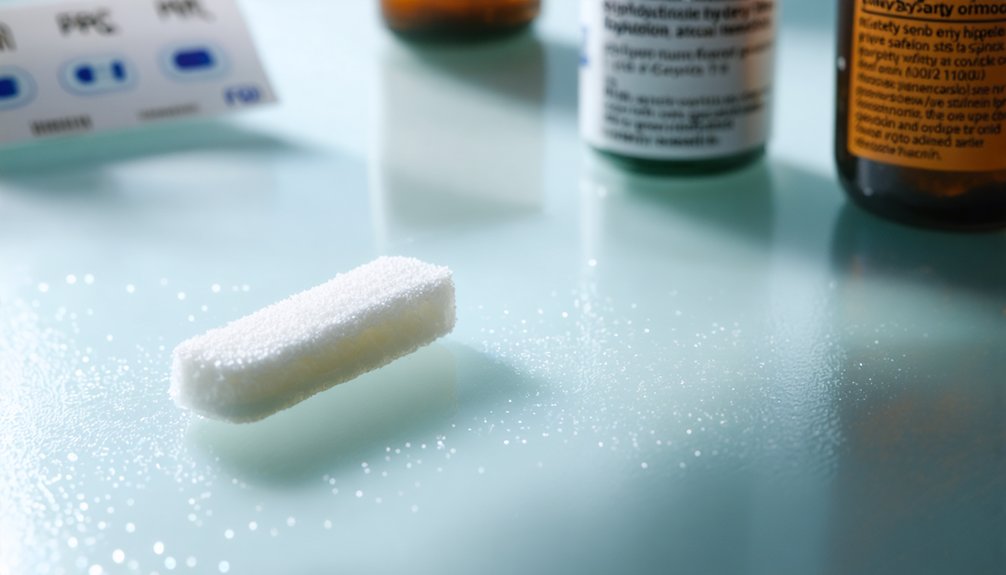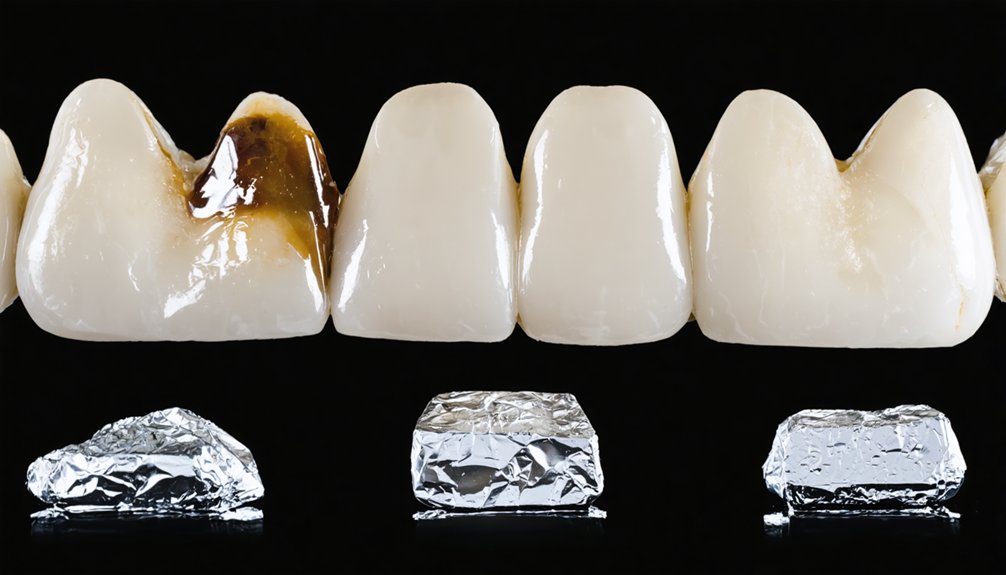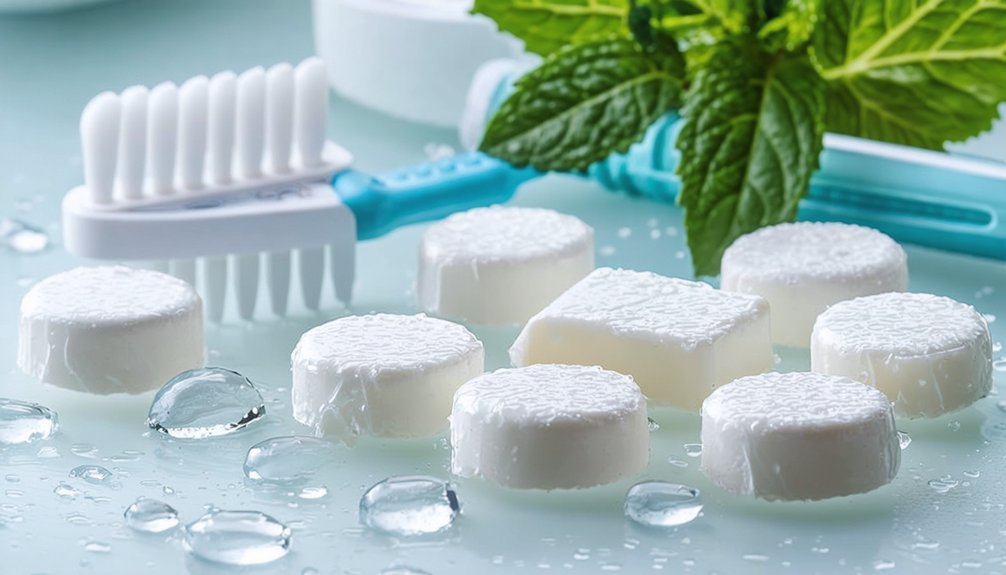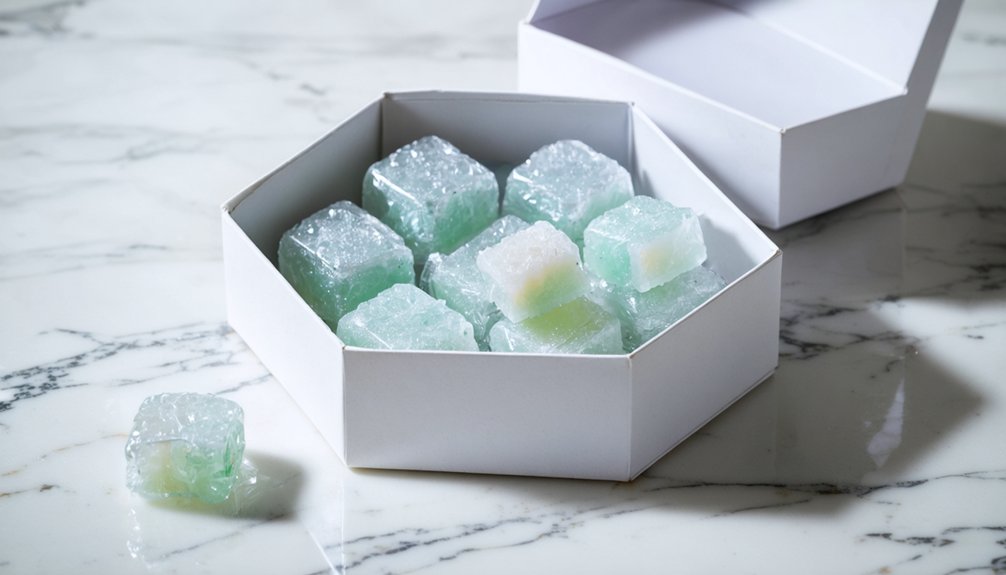You can effectively whiten discolored teeth on-the-go with specialized whitening gum containing proven ingredients like sodium bicarbonate and titanium dioxide. This portable option works by stimulating saliva production while its mild abrasives and polyphosphates target surface stains from coffee, tea, and smoking. For best results, chew sugar-free formulations for 15 minutes after meals, maintaining proper oral hygiene alongside use. Understanding the science behind whitening gum’s mechanism will help maximize your brightening results.
Key Takeaways
- Whitening gum offers convenient, portable teeth whitening through active ingredients like sodium bicarbonate and titanium dioxide while stimulating saliva production.
- Regular use of whitening gum after meals or staining drinks can reduce surface discoloration by 15-50% over time.
- For best results, chew sugar-free whitening gum for 15 minutes twice daily after brushing and flossing.
- Whitening gum works primarily on extrinsic stains from coffee, tea, and smoking, creating a gradual optical whitening effect.
- Though less effective than professional treatments, whitening gum helps maintain whiteness and prevent new stains during daily activities.
Understanding the Science Behind Whitening Gum
While many people seek teeth whitening solutions, understanding the scientific mechanism behind whitening gum can help set realistic expectations for its use. The mechanism overview reveals that whitening gum primarily functions by stimulating salivary production, which naturally cleanses your teeth of surface stains. The whitening effect is far less potent than professional treatments like Zoom Whitening that use hydrogen peroxide as their active ingredient. Professional treatments can yield longer-lasting effects compared to whitening gum and other over-the-counter options.
When examining stain types, it’s essential to differentiate between extrinsic and intrinsic discoloration. Whitening gum effectively targets extrinsic stains – those on the tooth surface from coffee, tea, or smoking.
However, it can’t address intrinsic stains located within your tooth’s structure. The gum’s ingredients create an optical whitening effect while simultaneously promoting oral health by neutralizing acids and reducing plaque formation.
You’ll achieve ideal results when using whitening gum as part of a thorough dental care routine.
Key Ingredients That Power Tooth Brightening
Understanding the key ingredients in whitening gum reveals a sophisticated blend of active compounds that work synergistically to brighten your teeth.
The primary stain removal agents include sodium bicarbonate and titanium dioxide, which provide controlled abrasive action to lift surface discoloration. Calcium peroxide and other metal peroxides release oxygen molecules that penetrate the enamel for deeper whitening effects.
The powerful combination of abrasive agents and peroxide compounds work together to remove surface stains and whiten teeth from within.
You’ll find natural sweeteners like xylitol not only enhance taste but actively prevent tooth decay by inhibiting bacterial growth. The increased saliva production during chewing helps naturally wash away staining particles and bacteria.
The formulation’s effectiveness relies on precise concentrations of citrates and tetrasodium pyrophosphate, which break down stubborn stains.
For those seeking natural options, ingredients like parsley extract and neem oil contribute additional oral health benefits while supporting the primary whitening action of peroxide compounds. Regular chewing may require up to three months of use before visible results appear.
How Whitening Gum Tackles Surface Stains
Building on the sophisticated ingredient profile, whitening gum’s stain-fighting power comes from a dual-action approach combining mechanical and chemical processes.
When you chew, mild abrasives physically scrub your enamel while polyphosphates chemically disrupt stain molecules. The natural increase in saliva flow enhances surface stain removal by washing away loosened particles and supporting the chemical agents’ effectiveness. The gum’s mechanical action targets external staining caused by common substances like coffee and wine.
Your chewing motion works with hydrated silica particles to dislodge extrinsic stains, while ingredients like sodium hexametaphosphate prevent new stain formation. Unlike professional whitening treatments that use hydrogen peroxide bleaching, whitening gum relies solely on surface stain removal methods.
Gum effectiveness peaks after 60-120 minutes of cumulative chewing, achieving 15-50% reduction in surface discoloration. While less potent than peroxide treatments, whitening gum offers continuous maintenance through regular use, making it a practical solution for daily stain control.
Daily Usage Guidelines and Best Practices
To optimize your whitening results, chew each piece of whitening gum for exactly 15 minutes after thoroughly brushing and flossing your teeth.
You’ll need to maintain consistent daily usage according to your product’s specific guidelines, which typically recommend 1-2 sessions per day. For best results, avoid consuming dark staining substances like coffee, tea, or red wine during your whitening treatment period. Consider storing your whitening gum in the refrigerator to maintain its effectiveness.
If you experience any tooth sensitivity or gum irritation, discontinue use immediately and consult your dental professional for guidance.
Recommended Daily Chewing Schedule
While establishing an effective whitening regimen requires consistency, following the recommended daily chewing schedule guarantees perfect results from your portable whitening gum.
You’ll want to chew the whitening gum for 15 minutes, once or twice daily, integrating this practice into your regular oral hygiene routine. For maximum efficacy, time your chewing frequency between regular brushing and flossing sessions. Using whitening products too frequently can lead to uneven whitening results.
Monitor your duration recommendations carefully, as different products may specify varying usage guidelines based on their active ingredients. Using products with hydrogen peroxide as the active whitening agent typically yields the most effective results.
You’ll need to consult your dental professional before starting any whitening regimen, especially if you have existing dental conditions or sensitivities.
Remember to maintain consistent intervals between chewing sessions and avoid exceeding the recommended daily usage to prevent potential tooth sensitivity or adverse effects.
Maximizing Whitening Results
Maximizing the effectiveness of whitening gum requires a strategic approach that combines proper timing, complementary oral care practices, and lifestyle modifications.
To optimize results, chew immediately after meals or staining beverages, limiting sessions to 10-15 minutes. Your chewing techniques should focus on gentle, consistent motion to activate whitening agents without causing excessive mechanical wear.
Monitor your dietary impacts by reducing chromogenic substances like coffee, tea, and red wine. When you do consume staining foods, use the whitening gum promptly afterward.
Support your whitening efforts by maintaining proper oral hygiene with fluoride toothpaste and regular flossing. Remember to rinse after chewing to prevent redeposition of loosened stains.
Choose sugar-free formulations containing xylitol and clinically-proven whitening agents like sodium bicarbonate for safe, consistent results.
Safety Considerations and Precautions

To guarantee safe whitening outcomes, you’ll need to carefully follow the product’s specified usage duration and frequency guidelines while monitoring for any signs of tooth sensitivity or gum irritation.
You should discontinue use immediately if you experience persistent discomfort and consult your dental professional for a thorough evaluation.
Prior to beginning any whitening regimen, it’s crucial to conduct a patch test and verify that you don’t have any active oral conditions that could be aggravated by the peroxide-based whitening agents.
Safe Usage Guidelines
Three essential safety guidelines govern the use of portable whitening chewing gum.
First, select only ADA-approved products with appropriate peroxide concentrations, dispelling common whitening myths about stronger formulations being more effective.
Second, maintain proper technique by brushing beforehand and minimizing gum contact while chewing, following dental tips for ideal results.
Third, protect your oral tissues by monitoring for irritation and allowing adequate rest periods between treatments.
To guarantee safety, you’ll want to rinse thoroughly after use and avoid swallowing the whitening agents.
If you’re using custom trays or gels, apply a protective petroleum jelly barrier to prevent soft tissue contact.
Remember to discontinue use immediately if you experience any gum sensitivity or discomfort, and consult your dental professional before starting any whitening regimen.
Sensitivity Prevention Tips
When using whitening chewing gum, implementing proper sensitivity prevention measures guarantees a comfortable experience while protecting your dental health.
For effective sensitivity management, use desensitizing toothpaste containing potassium nitrate at least two weeks before starting your whitening regimen. This helps block nerve signals and reduces potential discomfort.
To enhance nerve protection, avoid acidic foods and beverages during your whitening period, as they can increase enamel erosion. Instead, incorporate calcium-rich foods to support remineralization.
If you experience sensitivity, use fluoride mouthwash and maintain gentle brushing techniques. Don’t exceed recommended usage times for the whitening gum, as overuse may lead to increased sensitivity.
For best results, allow recovery periods between whitening sessions and consult your dentist if persistent sensitivity occurs.
Comparing Whitening Gum to Professional Treatments
Although whitening chewing gum offers convenience and accessibility, professional dental whitening treatments remain considerably more effective for achieving noticeable teeth whitening results.
When comparing whitening methods, professional treatments can lighten teeth by up to 8 shades in a single session, while whitening gum typically achieves only 1-2 shades of improvement over extended periods.
Professional efficacy stems from higher concentrations of hydrogen peroxide (15-40%) and controlled application methods.
Your dentist can customize professional treatments to address both extrinsic and intrinsic stains, unlike whitening gums that only target surface discoloration.
While you’ll spend more initially on professional treatments, they deliver faster, more dramatic results lasting 1-3 years.
Whitening gums serve best as a maintenance option between professional treatments rather than a primary whitening solution.
Real Results: What to Expect From Regular Use

Understanding realistic expectations for whitening gum helps patients make informed choices about this convenient oral care option.
You’ll notice immediate results through surface stain removal, typically seeing 2-3 shade improvements within minutes after chewing. However, these effects are temporary and subtle compared to professional treatments.
For lasting results, you’ll need consistent use over weeks. The gum’s mild abrasives and mechanical action gradually reduce extrinsic stain accumulation while stimulating beneficial saliva production.
While it won’t address intrinsic discoloration or match peroxide-based treatments’ effectiveness, regular use can help maintain existing whitening results and prevent new stains from settling.
You can expect gradual improvements in surface brightness, particularly when combined with proper oral hygiene practices. The gentle, non-peroxide formula guarantees safe daily use with minimal risk of sensitivity.
Maximizing Benefits Through Proper Technique
To maximize the whitening potential of your portable gum, proper technique plays an essential role in achieving ideal results.
Begin by thoroughly cleaning your teeth to remove debris and guarantee the best contact between the whitening agents and your enamel. Maintain a consistent chewing rhythm for 15 minutes, focusing on targeted areas with notable staining while using gentle pressure to prevent jaw strain.
For best efficacy, you’ll want to use the product on a clean palate, away from meals and acidic beverages. Keep the gum moving throughout your mouth, even after flavor diminishes, to provide thorough coverage.
Once you’ve completed your session, rinse thoroughly to remove residual particles. Remember to follow manufacturer guidelines for daily frequency, and monitor for any sensitivity.
Store your whitening gum properly to maintain its active ingredients’ effectiveness.
Combining Whitening Gum With Other Dental Care Methods

When integrating whitening gum into your thorough dental care routine, synergistic effects can be achieved through strategic combinations with other whitening methods.
You’ll maximize whitening gum benefits by pairing it with professional treatments, while the gum’s gentle abrasives help maintain results between sessions.
For enhanced dental health synergy, combine whitening gum with fluoride toothpaste and antimicrobial rinses to protect enamel and support oral microbiome balance.
You’ll optimize results by chewing whitening gum after consuming staining beverages like coffee or tea. The increased saliva production helps neutralize acids and wash away chromogens.
Remember to maintain consistent oral hygiene practices, including twice-daily brushing and regular flossing, while using whitening gum.
Consult your dental professional before combining multiple whitening products to prevent sensitivity or irritation.
Frequently Asked Questions
Can Whitening Gum Help With Coffee and Wine Stains During Travel?
While you’re on-the-go, whitening gum offers travel convenience for managing fresh coffee and wine stains. You’ll find it helps prevent surface discoloration when used promptly after consuming staining beverages.
Will Sugar-Free Whitening Gum Affect Dental Fillings or Crowns?
While whitening gum won’t change your fillings or crowns’ color, moderate sugar-free gum use is safe for dental health. Avoid excessive chewing that could stress restorations or weaken their bonds.
How Long Should I Wait After Meals Before Using Whitening Gum?
Like a shield protecting a warrior, you don’t need to wait – chew whitening gum right after meals for ideal post-meal benefits. It’ll stimulate saliva production and help neutralize harmful acids immediately.
Can Children Safely Use Whitening Gum Products?
You shouldn’t let children use whitening gum, as it can damage their developing enamel. For children’s dental health, wait until age 14 and consult a dentist about safe ingredients first.
Does Whitening Gum Work Differently on Natural Versus Artificial Teeth?
Like sunlight affecting different surfaces, whitening gum only brightens your natural teeth through gentle abrasion and peroxide action. Your artificial teeth won’t change color, potentially creating shade disparities.
References
- https://www.miamiperio.com/blog/can-whitening-gum-help-lighten-my-teeth
- https://glenburniedentalgroup.com/blog/teeth-whitening-gum-guide/
- https://elitesmilesdds.com/teeth-whitening-gum/
- https://www.sundancesmiles.com/blog/teeth-whitening-gum-effective-know-the-truth/
- https://healthcare.utah.edu/the-scope/health-library/all/2023/10/does-home-teeth-whitening-really-work
- https://www.trysnow.com/blogs/news/can-i-chew-gum-after-teeth-whitening
- https://pubmed.ncbi.nlm.nih.gov/26054175/
- https://www.supersmile.com/products/freshen-breath-teeth-whitening-gum-stain-removal-on-the-go
- https://opendentistryjournal.com/VOLUME/16/ELOCATOR/e187421062208150/FULLTEXT/
- https://myashburndentist.com/the-science-behind-teeth-whitening-what-you-need-to-know/



